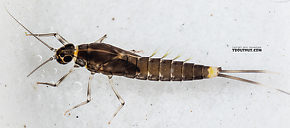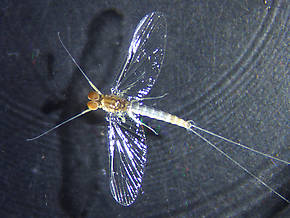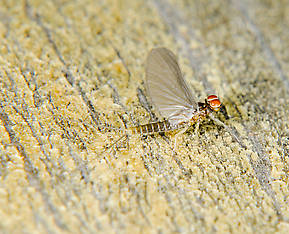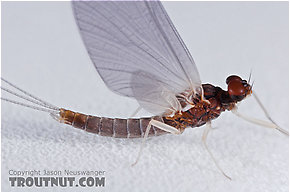Blog & Latest Updates
Fly Fishing Articles
Insects by Common Name


Iron Blue Quills
Scientific Names
Like most common names, "Iron Blue Quill" can refer to more than one taxon. They're previewed below, along with 6 specimens. For more detail click through to the scientific names.
Mayfly Species Diphetor hageni
These are often called Iron Blue Quills.
This is one of the most important species of the Baetidae family. Previously known as Baetis parvus in the West and its synonym (Synonym: A former name of a taxon, usually a species. Entomologists frequently discover that two insects originally described as different species are one in the same, and they drop one of the names. The dropped name is said to be a synonym of the remaining name. These changes take a while to trickle into the common knowledge of anglers; for example, Baetis vagans is now a synonym of Baetis tricaudatus.) Baetis devinctus in the East, it is distributed across the country but most of its fame comes from excellent hatches in the West. Prior to all the species being combined with Baetis tricaudatus, most angling literature considered it the most populous and widespread western species of the Baetidae family.
Dorsal (Dorsal: Top.) abdominal markings on the nymphs used to differentiate the species in these older works have since proved unreliable. The easiest way to tell them apart from B. tricaudatus is their lack of gills on the first abdominal segment. Telling adults apart is equally tough. Duns of D. hageni are typically a little smaller, but their bodies can also be olive, brownish olive and even two toned with thoraxes a shade of brown or tan with paler olivacious abdomens.
Diphetor hageni has two former names used in angling literature, Baetis parvus in the West and Baetis divinctus in the East.
Dorsal (Dorsal: Top.) abdominal markings on the nymphs used to differentiate the species in these older works have since proved unreliable. The easiest way to tell them apart from B. tricaudatus is their lack of gills on the first abdominal segment. Telling adults apart is equally tough. Duns of D. hageni are typically a little smaller, but their bodies can also be olive, brownish olive and even two toned with thoraxes a shade of brown or tan with paler olivacious abdomens.
Diphetor hageni has two former names used in angling literature, Baetis parvus in the West and Baetis divinctus in the East.
Mayfly Species Baetis magnus
These are often called Iron Blue Quills.
This large western baetid is in the Rhodani group of closely related species that could probaly also be called the baetis tricaudatus species complex. Besides its large overall size, large hind wings (for a baetid) with rounded margins and dark lateral (Lateral: To the side.) bands of pigment on the abdomen are are also characteristic.
Mayfly Species Labiobaetis propinquus
These are sometimes called Iron Blue Quills.
This species was previously known as Baetis propinquus, a name from older nomenclatures and angling literature familiar to many western anglers. Prior to its current listing, it did a brief stint in the genus Pseudocloeon. The irony is that though this species has hind wings, it was the last species remaining in Pseudocloeon (before the genus recent Nearctic taxonomic demise) which was best known for its species lacking hind wings as an identifying character.
Though it has a national distribution its most important hatches occur in the West, usually hatching between the larger broods of Baetis tricaudatus. Western anglers experiencing a hatch can easily confuse them with the larger Baetis bicaudatus as both nymphs appear similar with only two tails. Besides size, the adults can be separated from bicaudatus (with the help of a little magnification) because L. propinquus lacks acute costal projections (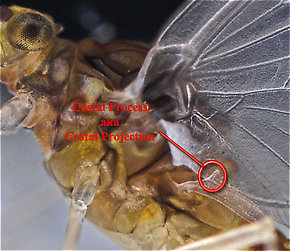 Costal projection: A bump or point sticking up from the front margin of an insect's wing, usually the rear wing of certain mayflies. It is sometimes called a costal process.) on its tiny hind wings. Conversely, the presence of hind wings and lack of conical mesonotal projections (Conical mesonotal projection: small cone shaped spike sticking up from the top and front part of the middle thorax segment.) makes them easy to tell from the more common and equally tiny Acentrella turbida.
Costal projection: A bump or point sticking up from the front margin of an insect's wing, usually the rear wing of certain mayflies. It is sometimes called a costal process.) on its tiny hind wings. Conversely, the presence of hind wings and lack of conical mesonotal projections (Conical mesonotal projection: small cone shaped spike sticking up from the top and front part of the middle thorax segment.) makes them easy to tell from the more common and equally tiny Acentrella turbida.
Though it has a national distribution its most important hatches occur in the West, usually hatching between the larger broods of Baetis tricaudatus. Western anglers experiencing a hatch can easily confuse them with the larger Baetis bicaudatus as both nymphs appear similar with only two tails. Besides size, the adults can be separated from bicaudatus (with the help of a little magnification) because L. propinquus lacks acute costal projections (

The costal projection of a Baetidae dun.
Mayfly Species Baetis tricaudatus
These are sometimes called Iron Blue Quills.
Baetis tricaudatus is undeniably the most widespread and abundant baetid on the continent and arguably the most important mayfly species to trout and anglers alike. Eastern anglers used to know these important mayflies by the storied name of Baetis vagans. Conversely, the usually much larger and late Fall hatching brood of Baetis tricaudatus was considered an important Western species with its own tradition. But, entomologists recently determined that they are both in fact the same species. The nomenclature conventions guiding entomologists do not account for a name's regional fame among fishermen, and new or obscure species names may replace their old favorites. Sometimes taxa with disparate traditions are combined. Baetis vagans is one such casualty. Fortunately, trout think like Shakespeare: A rose by any other name would smell as sweet. The rose that was vagans has lost none of its charm. This species is multibrooded (Multibrooded: Producing more than one generation in a single year. Baetis mayflies are a classic example. Insects which produce a single generation with two distinct peaks (like the June and September hatches of Isonychia bicolor mayflies) are not multibrooded, because the fall insects are offspring from the previous fall instead of the current year's spring.) with the hatches of Spring being larger flies. As the weather warms the following broods are composed of progressively smaller flies. In the East, they range in size from 16 to 20. In the West, they may run a size larger.
Male Baetis tricaudatus (Blue-Winged Olive) Mayfly Nymph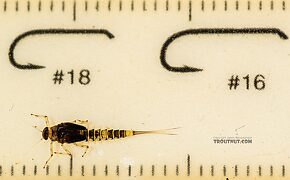 View 14 PicturesThis specimen and many like it were found with other specimens I found to be duller-colored females of the same species. I wasn't aware of such a difference between male and female nymphs in Baetids, but all the morphological characteristics I checked in the key were the same, and the color patterns are, too -- just not the brightness.
View 14 PicturesThis specimen and many like it were found with other specimens I found to be duller-colored females of the same species. I wasn't aware of such a difference between male and female nymphs in Baetids, but all the morphological characteristics I checked in the key were the same, and the color patterns are, too -- just not the brightness.
 View 14 PicturesThis specimen and many like it were found with other specimens I found to be duller-colored females of the same species. I wasn't aware of such a difference between male and female nymphs in Baetids, but all the morphological characteristics I checked in the key were the same, and the color patterns are, too -- just not the brightness.
View 14 PicturesThis specimen and many like it were found with other specimens I found to be duller-colored females of the same species. I wasn't aware of such a difference between male and female nymphs in Baetids, but all the morphological characteristics I checked in the key were the same, and the color patterns are, too -- just not the brightness.Male Baetis tricaudatus (Blue-Winged Olive) Mayfly Dun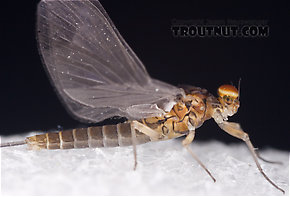 View 8 PicturesThis male was associated with a female of the same species.
View 8 PicturesThis male was associated with a female of the same species.
 View 8 PicturesThis male was associated with a female of the same species.
View 8 PicturesThis male was associated with a female of the same species.See 8 more specimens...
Mayfly Species Neoleptophlebia mollis
These are very rarely called Iron Blue Quills.
This species often emerges together with Paraleptophlebia strigula and Paraleptophlebia guttata, and the combined effect can be a good fishable hatch. The latter two are much less famous than mollis, but Knopp and Cormier say they are more reliable.
Top 10 Fly Hatches
Top Gift Shop Designs
Eat mayflies.
Top Insect Specimens
Miscellaneous Sites
Troutnut.com is copyright © 2004-2024 Jason
Neuswanger (email Jason). See my FAQ for information about use of my images.
 privacy policy
privacy policy

